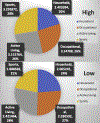The impact of physical activity during pregnancy on labor and delivery
- PMID: 34081895
- PMCID: PMC10564562
- DOI: 10.1016/j.ajog.2021.05.036
The impact of physical activity during pregnancy on labor and delivery
Abstract
Background: Physical activity in pregnancy is associated with decreased risks of adverse pregnancy outcomes such as gestational diabetes and preeclampsia. However, the relationship between the amount and type of physical activity during pregnancy and subsequent labor outcomes remains unclear.
Objective: This study aimed to test the hypothesis that higher levels of physical activity across different lifestyle domains in pregnancy are associated with a shorter duration of labor.
Study design: This study is a secondary analysis of a prospective cohort study in which patients with singleton pregnancies without a major fetal anomaly were administered the Kaiser Physical Activity Survey in each trimester. The Kaiser Physical Activity Survey was designed specifically to quantify various types of physical activities in women and includes 4 summative indices-housework/caregiving, active living habits, sports, and occupation. The study included women at full-term gestations admitted for induction of labor or spontaneous labor. The primary outcome of this analysis was duration of the second stage of labor. Secondary outcomes were duration of the active stage, prolonged first and second stage, mode of delivery, rates of second-stage cesarean delivery, operative vaginal delivery, severe perineal lacerations, and postpartum hemorrhage. These outcomes were compared between patients with and without high physical activity levels, defined as overall Kaiser Physical Activity Survey score ≥75th percentile in the third trimester. Multivariable logistic regression was used to adjust for obesity and epidural use. In addition, a subgroup analysis of nulliparous patients was performed.
Results: A total of 811 patients with complete Kaiser Physical Activity Survey data in the third trimester were included in this analysis. The median Kaiser Physical Activity Survey score was 9.5 (8.2-10.8). Of the 811 patients, 203 (25%) had higher levels of physical activity in pregnancy. There was no difference in the duration of the second stage of labor between patients with and without higher physical activity levels (1.29±2.94 vs 0.97±2.08 hours; P=.15). The duration of active labor was significantly shorter in patients with higher levels of physical activity (5.77±4.97 vs 7.43±6.29 hours; P=.01). Patients with higher physical activity levels were significantly less likely to have a prolonged first stage (9.8% vs 19.4%; P<.01; adjusted relative risk, 0.55; 95% confidence interval, 0.34-0.83). However, rates of prolonged second-stage cesarean delivery, operative vaginal deliveries, and perineal lacerations were similar between the 2 groups.
Conclusion: Patients who are more physically active during pregnancy have a shorter duration of active labor.
Keywords: KPAS; activity; duration; exercise; labor.
Copyright © 2021 Elsevier Inc. All rights reserved.
Conflict of interest statement
The authors report no conflict of interest.
Figures
References
-
- Dempsey JC, Butler CL, Sorensen TK, et al. A case-control study of maternal recreational physical activity and risk of gestational diabetes mellitus. Diabetes Res Clin Pract 2004;66:203–15. - PubMed
-
- Sorensen TK, Williams MA, Lee IM, Dashow EE, Thompson ML, Luthy DA. Recreational physical activity during pregnancy and risk of preeclampsia. Hypertension 2003;41:1273–80. - PubMed
-
- Currie LM, Woolcott CG, Fell DB, Armson BA, Dodds L. The association between physical activity and maternal and neonatal outcomes: a prospective cohort. Matern Child Health J 2014;18:1823–30. - PubMed




